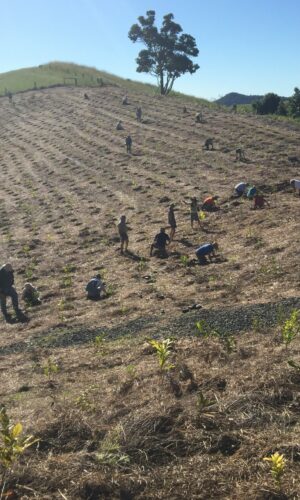Revegetation is the process of establishing native vegetation on disturbed land to repair the landscape, and can occur through natural plant colonisation or human intervention. The type of revegetation depends on the objective of the planting, the size and nature of the site, together with available time and finances. Typically, the planning and site maintenance stages require the most time and are the most important for success.
The four stages to any revegetation project are:
- planning
- site preparation
- planting
- maintenance.
Different revegetation project types include:
- habitat — medium to high diversity of species
- framework — low diversity of species
- creek bank stabilisation using flood tolerant species
- timber harvesting
- windbreaks and shelter belts
- amenity plantings — usually small-scale, urban/non-urban
- assisted natural regrowth.

Site preparation primarily involves the removal of competition from woody weeds and grasses, but may also include exclusion fencing and/or ripping. All weeds and pasture grasses should be removed prior to planting, typically by herbicide. In waterways, some vegetation cover (grasses and weeds) should be retained initially to maintain site stability. Eradication of these species can occur at the end of the wet season when flooding is unlikely. The site needs to be stock-proof. A four-strand wire fence is most suitable with a plain wire top strand to reduce wildlife strike. Electric fencing can also be used if it is checked regularly to ensure vegetation does not short out the fence. Contour ripping up to 300mm depth can increase plant establishment where soil has been heavily compacted, such as on old roads and cattle pads. However, ripping can also promote weed species through disturbance of the seed bank. Do not rip steep slopes or river and creek flats.
It is essential to think about what factors may affect the project’s success. Planning should consider site characteristics, timing of planting, permissions/permits, powerlines and other utilities, and sourcing appropriate plant species. Site characteristics, including soil type, slope, accessibility, rainfall and proneness to flooding and frost, will help determine the most suitable plant species and revegetation methodology for your site.
Site preparation primarily involves the removal of competition from woody weeds and grasses, but may also include exclusion fencing and/or ripping. All weeds and pasture grasses should be removed prior to planting, typically by herbicide. In waterways, some vegetation cover (grasses and weeds) should be retained initially to maintain site stability. Eradication of these species can occur at the end of the wet season when flooding is unlikely. The site needs to be stock proof. A four-strand wire fence is most suitable with a plain wire top strand to reduce wildlife strike. Electric fencing can also be used if it is checked regularly to ensure vegetation does not short out the fence. Contour ripping up to 300mm depth can increase plant establishment where soil has been heavily compacted, such as on old roads and cattle pads. However, ripping can also promote weed species through disturbance of the seed bank. Do not rip steep slopes or river and creek flats.
The optimum spacing between trees is between 1.5 and 2m. Trees should be planted in staggered rows to reduce the overall maintenance period.

Large scale tree plantings are best tackled in the wet season when growing conditions and rainfall are optimal. This also ensures plants become established before winter frosts and the dry season. Holes should be approximately twice the width and depth of the pot of the tree being planted. Place fertiliser that is less than 3% phosphorous in the bottom of the hole and cover with dirt to prevent root burn. Water trees directly after planting with a minimum of 10L/tree. If planting coincides with adequate rainfall, then this is not necessary.
If rainfall is low in subsequent months, additional watering may be required. Irrigation is only required if the site is particularly harsh and will only be necessary for up to two years until the plants are well established. Uncontrolled weeds and grasses in the first 2–3yrs can greatly reduce the plants’ overall growth. This may result in an extended maintenance period and increased costs. Removal of weeds and grasses is typically required for 3–4yrs. Herbicide application or heavy mulching can be used, however mulching is impractical for large sites. Mulch may need to be re-applied several times in the first 2–3yrs or until canopy closure is reached.

